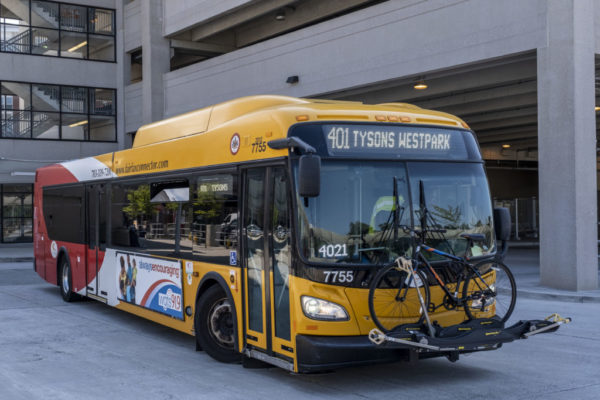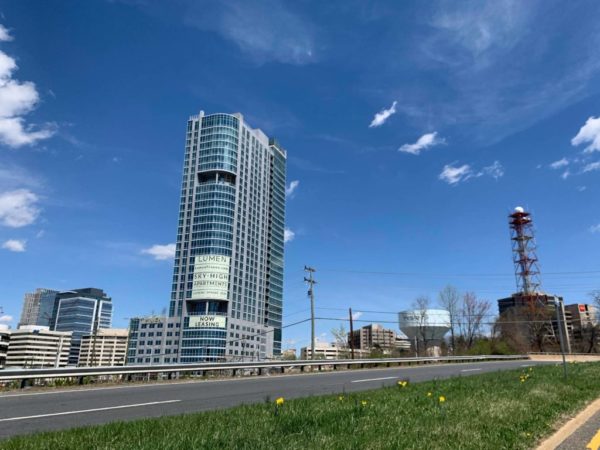Starting over Labor Day weekend, transfers between Metro trains and Fairfax Connector buses will be free.
The Fairfax County Department of Transportation (FCDOT) said yesterday (Monday) it has partnered with the Washington Metropolitan Area Transit Authority (WMATA) to provide free transfers on nearly all Connector bus routes beginning on Sunday (Sept. 5).
This lines up with Metro’s new policy of also offering free bus transfers, which was first announced earlier this month.
“Fairfax Connector has historically aligned fare policies with Metrobus and by doing so, helps create a seamless experience for users when moving between transit services provided by WMATA and the County,” FCDOT spokesperson Robin Geiger wrote in an email. “That’s why we are partnering with WMATA to extend their program to Fairfax Connector bus service to provide good customer service and provide incentives to ride transit.”
The two exceptions will be the Fairfax Connector Express Service and the Wolf Trap shuttle. Both will be discounted by $2, though, with the use of WMATA’s SmarTrip card or app.
This is a pilot program that will operate for the next 10 months, through early July 2022, Geiger says.
Fairfax Connector serves all Metro stations located in Fairfax County. The transit system recently expanded service in the Falls Church area by taking over five Metrobus routes, four of which had ceased operations during the pandemic.
Additionally, the Wolf Trap shuttle will start again operating on Sept. 5. The shuttle runs between the West Falls Church Metro station and Wolf Trap National Park’s Filene Center.
The new policy is part of a larger push to encourage increased ridership on the Fairfax Connector as schools, offices, and other public places reopen amid the COVID-19 pandemic.
“We hope that when people go back to their workplaces, they consider returning to or trying transit for the first time,” writes Geiger. “Now, is the time to ride because the free transfer from Fairfax Connector to Metrorail or from Metrorail to Fairfax Connector saves money and because Fairfax Connector continues to provide a safe and healthy environment on buses.”
In May, county officials said they were reviewing possibly reducing or even eliminating fares altogether on the Fairfax Connector.
To help with this, the county was planning to apply for grant funds from Virginia’s Transit Ridership Incentive Program. The application deadline for the program is Sept. 17. Geiger says there’s currently no additional information on the possibility of reducing or eliminating fares.
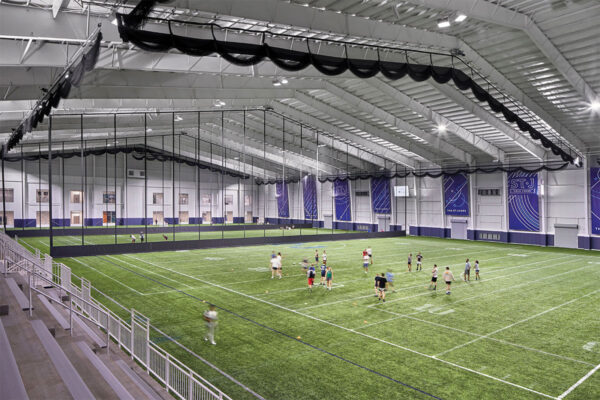
Fairfax County has joined three other Virginia localities to create SportsNOVA, a marketing partnership aimed at promoting Northern Virginia as a destination for sporting events.
As the county’s official tourism organization, Visit Fairfax announced on Aug. 10 that it has aligned with the marketing arms of Loudoun, Prince William, and Strafford counties to promote and pitch the region.
The agencies believe the location, availability of already-built venues, and accessibility of public transportation make Northern Virginia an ideal place for sports tournaments, events, and championships.
Eric Kulczycky, Visit Fairfax’s national sales manager, says sports can be a huge economic driver for a region, and he hopes that this partnership can help better capture those dollars.
“[Sporting events] can generate taxes and jobs,” he said. “Through visitor spending like hotel stays, eating at restaurants, buying tickets to [events]…Our mission is to generate additional spending and get new money coming into our communities.”
There is evidence that sports drive considerable economic activity. One 2019 study conducted by a sports tourism trade association found that 180 million trips were made in the U.S. for sporting events — from youth to professional leagues — with more than half of those trips being overnight.
Visitors who stayed overnight spent $359 per person on average.
Northern Virginia has hosted a number of large sports events in recent years, including the 2015 World Police & Fire Games, the 2017 Senior PGA Championship, and a Kayak Bass Fishing tournament this past May.
The hope, Kulczycky says, is to entice more events of this nature, like regional hockey tournaments and more senior-centric sporting events.
One of the main selling points is that the county and region have a number of available venues, several of which are relatively new.
The St. James complex in Springfield opened in 2018 and has a multitude of facilities, including four NBA-size basketball courts, two NHL-size rinks, a 50-meter Olympic pool, and indoor turf fields.
There is also George Mason University’s EagleBank Arena, which is on the verge of a major renovation. Elsewhere, there is Segra Field, which opened in Loudoun County two years ago, and the Jeff Rouse Swim and Sport Center in Stafford, which was also only completed a few years ago.
Kulczycky says there have been preliminary conversations in Fairfax County about opening additional indoor and outdoor sporting complexes as well.
Not every Northern Virginia locality is part of this partnership. Notably, Arlington County isn’t in the consortium. Kulczycky says Arlington officials have not been currently actively pursuing the sports tourism market, but there’s an “open invitation” for them to join.
Kulczycky says the decision to combine forces with other localities was due to the realization that being together was better.
“There are multi-sport and large single-sport events that Fairfax County simply cannot host unless we secure facilities in other jurisdictions,” he said.
Plus, Kulczycky notes that a combined marketing campaign is more cost-effective.
SportsNOVA is simply an extension of what Fairfax County and Northern Virginia has been trying to do separately for years.
“I’ve been doing this for 15 years and there’s always been an interest in hosting sports tournaments in Fairfax County and Northern Virginia,” Kulczycky said. “So, we’re just continuing to look to expand opportunities in the sports market.”

(Updated at 9:35 a.m.) Hurunnessa Fariad knows what it’s like to be an Afghan refugee.
She fled Afghanistan with her family in the 1980s while the country was under Soviet occupation. While the circumstances were certainly different three decades ago, her emotions upon seeing another exodus in the wake of the Taliban’s recent takeover are comparable to her own experiences.
“The sentiment of leaving your home, leaving everything behind…and coming to a country where you don’t know anything, you don’t know the culture, you don’t know the people, you don’t know who’s going to help you — it’s terrifying,” she said.
Today, Fariad works as outreach coordinator at the All Dulles Area Muslim Society — also known as the ADAMS Center — in Sterling. It’s the second-largest Muslim community in the country and serves people across Fairfax and Loudoun counties.
She also serves as the center’s Afghan lead, working with Lutheran Social Services to help those who have evacuated Afghanistan to make a new home in the U.S., joining many non-profit and faith-based organizations across the region.
The ADAMS Center is currently collecting funds to help with both immediate needs, such as gift cards to Target or Walmart that can be used to purchase basic items, and long-term needs for housing, jobs, and education.
Fariad says the center was collecting individual items, like toiletries and hygiene items, but they got “inundated” and need time to sort through all of the donations.
“The funding is going to keep going on for a while because there’s so many people coming in that they’re going to need help,” she said.
Additionally, the ADAMS Center is putting together a list of local residents who speak Dari and Pashto and can act as translators. They are sharing that list with both Virgina Gov. Ralph Northam’s office and the federal government.
As of yesterday (Tuesday), more than 6,000 people and 44 dogs have arrived at Dulles International Airport in the last week, according to an email from state officials to local partners.
Currently, new arrivals are temporarily being housed at the Dulles Expo Center in Chantilly. They were previously housed at Northern Virginia Community College in Annandale as well.
A Fairfax County spokesperson confirmed that the county is providing support for resettlement efforts, primarily assisting with health, human services, and public safety needs.
“Currently, the county is supporting a Department of State operation for people evacuated from Afghanistan and arriving at Dulles International Airport. Some of these individuals are being supported temporarily at Dulles Expo Center in Chantilly,” the county spokesperson wrote. “The center has the capacity to support more than a thousand individuals.”
The Fairfax County Office of Emergency Management also helped set up cots at Northern Virginia Community College, according to The Washington Post. Community members are being asked not to go to any of these hosting sites.
Fairfax County Board of Supervisors Chairman Jeff McKay visited the Dulles Expo Center yesterday, saying in a newsletter that he was “touched to hear the human side of what we are seeing on the news.”
“While we can’t be sure how many people will ultimately relocate to Fairfax County, I want to be clear that we look forward to welcoming all who want to join our diverse community,” he wrote. Read More
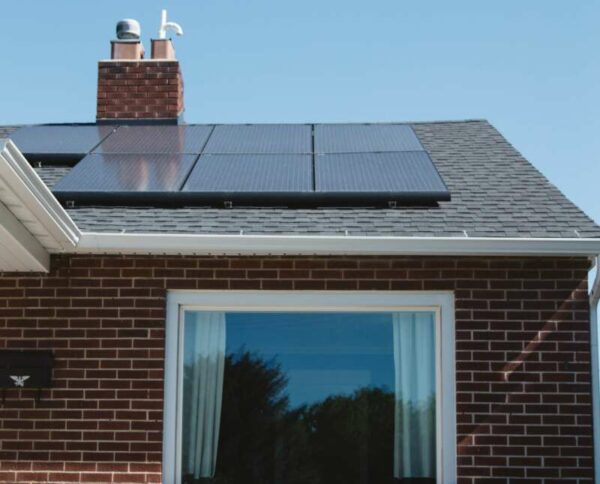
On the heels of last week’s sobering United Nations climate change report, Fairfax County is beginning to implement its first-ever Community-wide Energy and Climate Action Plan (CECAP), which sets goals for reducing greenhouse gas emissions.
Fairfax County staff delivered a final update of the CECAP to the Board of Supervisors during its environmental committee meeting on July 20. The board is expected to accept the report when it meets on Sept. 14.
The CECAP provides an inventory of current greenhouse gas emissions and recommends actions that the county and individuals can take to mitigate future emissions in order to achieve carbon neutrality within three decades.
“A lot of times, people feel like this problem is so big and out of their hands, that they feel like they can’t make a difference,” Fairfax County Office of Environmental and Energy Coordination Senior Community Specialist Maya Dhavale said. “I feel like it’s very timely that Fairfax County has been putting this plan and report together…We’re able to provide residents, business owners, and individuals in Fairfax County a path forward.”
Dhavale, who spearheaded the project, says staff have already begun the process of implementing the plan. That starts with community outreach, public education, and a review of existing county policies to determine how they line up with the proposed plan.
First proposed in 2018 and initiated in early 2020, the CECAP report was developed by a working group composed of environmental advocates, business representatives, civic association members, and other citizens.
As an overarching goal, the work group proposed that Fairfax County become carbon-neutral by 2050 with an 87% reduction in greenhouse gas emissions from 2005 levels.
The Board of Supervisors has already pledged to make county government operations — including building and facility energy use and transportation — carbon neutral by 2040 in conjunction with an updated operational energy strategy adopted on July 13.
The county’s recent push to prioritize environmental initiatives comes as the U.N. continues to sound the alarm on climate change as a crisis that’s already in motion and will only get worse without a substantial shift in human behavior.
In its latest report released on Aug. 9, the Intergovernmental Panel on Climate Change estimates that human activities are directly responsible for a roughly 1 degree Celsius climb in the global surface temperature from 1900 to 2019, contributing to retreating glaciers, rising sea levels, ocean acidification, and increased frequency and intensity of extreme weather events.
Even if future emissions are kept very low, global temperatures will continue going up until at least the mid-21st century and could very likely still be one to 1.8 degrees Celsius higher than 1900 levels by the end of the century, according to the report.
“Stabilizing the climate will require strong, rapid, and sustained reductions in greenhouse gas emissions, and reaching net zero CO2 emissions,” IPCC Working Group I Co-Chair Panmao Zhai said in a news release. “Limiting other greenhouse gases and air pollutants, especially methane, could have benefits both for health and the climate.”
In their report, the CECAP working group says the impact of climate change on Fairfax County is already evident in declining snowfall, more extremely hot days, heavier rainfall, and increased incidences of mosquito and tick-borne illnesses. Read More

Fairfax County’s final Dog Park Park Study calls for the construction of one new dog park, a timeline to build six more, and a better maintenance plan for existing parks.
After a nearly two-year long process full of surveys, drafts, and feedback, the Fairfax County Park Authority Board of Directors endorsed the final report at a meeting late last month.
The park authority initiated the study in 2019 due to the “abundance” of questions about county dog park operations and expansion, including the “perceived demand” for more parks. Feedback was gathered by surveying more than 4,600 residents.
According to a county press release, the final report will act as a “guiding document” for the county as it plans, designs, maintains, and operates dog parks going forward.
Recommendations in the final report include building at least one new dog park by 2025, though an exact location isn’t specified.
Currently, the county has 13 public dog parks, 11 of which are owned and operated by FCPA. An additional one would meet the needs of the county’s projected population in 2025, according to the park authority’s data.
Although the report doesn’t say exactly where the new park should be built, it suggests that McLean or Lake Fairfax in Reston would be good options due to demand and a lack of existing dog parks.
Park bond funding should be used for the building of the park, the report proposes.
After that dog park is completed, the report says the county should establish a schedule for constructing six more dog parks, which should meet and, even, exceed demand over the next two decades.
It recommends Baileys, Jefferson, and Bull Run planning districts as options for locations.
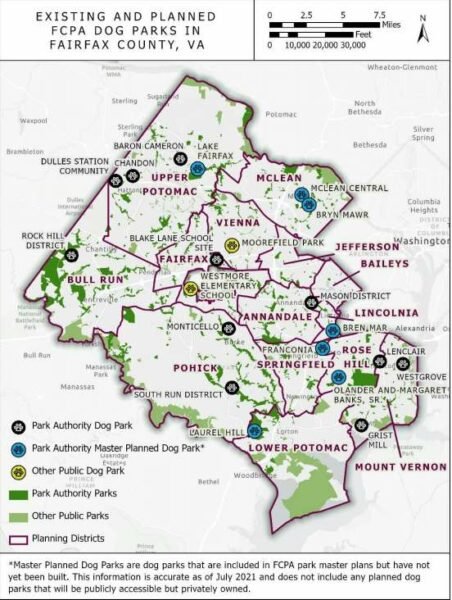
In terms of what those new dog parks should include, survey respondents noted that room for dogs to run, adequate number of trash cans, shade, water spickets, and parking were features most requested by residents.
The report also recommends developing a more thorough plan for park upkeep, including additional and better placement of trash cans, more frequent refilling of waste bag dispensers, and better signage. It says FCPA should encourage volunteer dog park teams to help with this upkeep.
In addition to addressing the state of dog parks countywide, the report makes recommendations for improvements to each individual dog park in that the park authority operates.
Suggested alterations range from converting a hose bib at the Baron Cameron dog park in Reston into a drinking fountain and installing a structure or planting trees to provide shade at Blake Lane in Oakton to redesigning Grist Mill Park in Alexandria to have a separate section for smaller and older dogs.
FCPA estimates that it costs just under $10,000 a year to maintain each dog park.
A draft of the report was first released in early March, which was followed by another public comment period that led the park authority to refine some of its recommendations.
The Tysons area is currently low on public dog parks. The Blake Lane park (10033 Blake Lane) is the closest one owned by the FCPA, and pups can also romp in an off-leash area at Moorefield Park in the Town of Vienna.
A dog park is being considered as part of the McLean Central Park redesign, but the proposal got some pushback after the park authority’s concept plan suggested it would require eliminating an existing tennis court.
The final dog park study report will be posted on the county’s website in September.
Photo via The Boro/Twitter
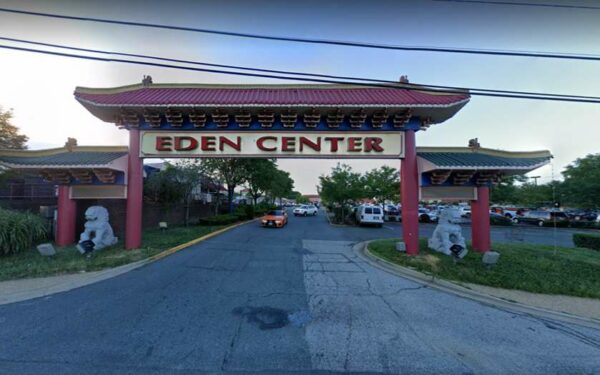
Local students are responsible for two new state historical highway markers that Virginia will install in recognition of Asian American Pacific Islander (AAPI) history.
Earlier this summer, students from across the Commonwealth submitted ideas for new historical markers as part of a contest celebrating AAPI Heritage month. Gov. Ralph Northam announced five winners on Aug. 3, including two that were submitted by students from the Fairfax County area.
Students from Hunters Woods Elementary in Reston nominated W.W. Yen for a marker. He was the first international student to earn a bachelor’s degree at the University of Virginia and went on to become an important leader in Chinese government. The school now has a dorm and scholarship named after him.
Mary Ellen Henderson Middle School students in Falls Church proposed highlighting their city’s Vietnamese immigrant community, which grew after the Fall of Saigon in 1975. During the subsequent surge in immigration to the U.S., many of the people who came to the D.C. area settled in Arlington’s Clarendon neighborhood and, later, Falls Church.
Today, the D.C. area is home to the third-largest Vietnamese community in the country, and the Eden Center is among the largest Vietnamese shopping centers.
The other new historical highway markers highlight Japanese American football player Arthur Azo Matsu, former Korean foreign minister Kim Kyusik, and Filipinos who served in the U.S. Navy.
“Throughout history, Asian American and Pacific Islander communities have made significant contributions to our Commonwealth and our country, but too often their stories remain untold,” Northam wrote in the press release. “As we continue working to tell a more comprehensive and inclusive Virginia story, I am grateful for the efforts of Virginia students and educators in helping elevate the voices of prominent AAPI Virginians with these five new historical markers.”
Now a rising fifth-grader at Hunters Woods Elementary, Benjamin Roxbury was in fourth grade when he and a few other students nominated Yen for the historical marker contest.
He hopes when people read it, they discover that learning is universal.
“Families may come from different parts of the world, but school brings us together,” Benjamin said. “I like that we get to learn from different people.”
Makayla Puzio, who taught him last year, says school officials told her about the contest and she thought it would be a good hands-on, project-based assignment to help students learn about state history and how to conduct research.
Other figures suggested by students in Puzio’s fourth-grade class included local author Helen Wan and peace activist Marii Kyogoku Hasegawa. But the nomination from Benjamin’s group ultimately stood out to the Virginia Department of Historic Resources, which chose the new markers.
“They were really excited,” Puzio said of the students’ reaction to their selection. “It makes them feel proud of the work that they did. I don’t know if they really thought that was going to happen.”
For Griffin and Oliver Hardi, the Henderson Middle School students behind the Eden Center marker, the opportunity to honor the local Vietnamese community and tell their stories resonated on a personal level.
“Our mom is an immigrant too, so it’s great to see Asian-American history recognized,” Griffin said by email. “And the food at the Eden Center is great!”
Puzio says this experience could become a point of pride for these students for the rest of their lives.
“One of these students could be touring UVA and remember this person and historical marker,” said Puzio. “And be like ‘hey, in fourth grade, I did this. I’m the reason that this marker is here!”
Photo via Google Maps
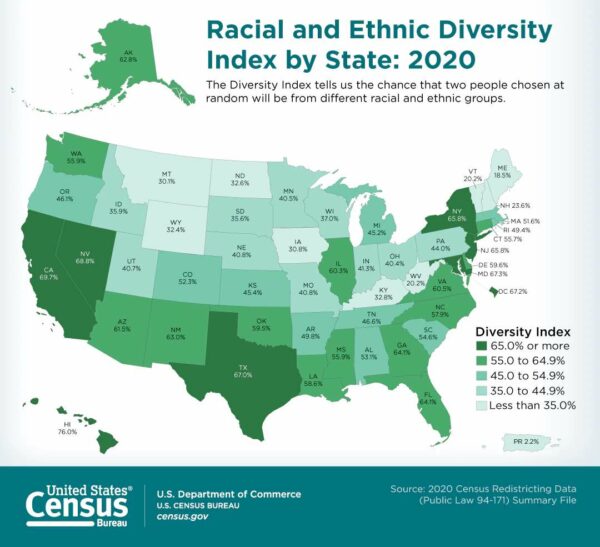
Fairfax County is now the second most racially diverse county in Virginia, according to 2020 Census data released yesterday afternoon (Aug. 12).
The data confirms recent demographic reports conducted by Fairfax County that showed the share of white residents shrinking and communities of color, particularly Asians and Hispanics, growing since 2010, when the county was the fifth-most diverse county.
Now, only Prince William County is more diverse.
Compared to the rest of the United States, Fairfax County ranked 42nd out of 3,143 counties in the country on the Census’ racial and ethnic diversity index.
While white residents remain the largest racial or ethnic group in the county, they are no longer the majority, making up 47.1% of the overall population with 542,001 residents — a drop of nearly 50,000 people from 2010, when the county’s 590,622 white residents constituted 54.6% of its population.
In other words, Fairfax is now a majority-minority county, due in part to the growth of the county’s Asian and Hispanic/Latino populations, which are the second and third largest racial and ethnic groups, respectively.
According to the 2020 Census data, 20.3% of the county’s population is Asian, an increase of about 55,000 residents from 17.4% in 2010. Hispanic or Latino individuals now constitute 17.3% of the populace, up from 15.6% a decade ago.
The diffusion score — the percentage of the population that isn’t in the top three racial and ethnic groups — is also higher than it was in 2010. At 15.2%, that number is also higher than Virginia and the country as a whole.
The county’s increasing diversity reflects national trends revealed in the new data, which shows the first-ever decline in the country’s white, non-Hispanic population with Latino residents fueling 51% of the population growth.
In total, about 1.15 million people now live in Fairfax County. The population grew by about 68,500 people or 6.3% since 2010, a lower rate of growth than both Virginia as a whole (7.9%) and the U.S. (7.4%).
Fairfax County’s population increase is also significantly lower in terms of percentage than its neighboring localities in Northern Virginia: Arlington County’s population rose by nearly 15%, Alexandria City by nearly 14%, Prince William County by about 20%, and Loudoun County by a staggering 35%.
However, Fairfax remains the largest county in Virginia, as it was in 2010, with more than double the population of Prince William County, which is the second most populous county. Fairfax County residents make up about 13% of the Commonwealth’s total population.
In general, Northern Virginia continues to grow at a much higher rate than the rest of the state.
The new Census data will be used to redraw voting districts locally and nationwide, a process that carries major political implications. Electoral districts are redrawn every 10 years to ensure each one has about the same number of people. The data could also change how many electoral votes are allocated to each state.
This is the 24th official Census count in U.S. history.
Fairfax County officials support the recent reinstatement of the federal eviction mortarium and plan to continue providing rental assistance to those in need.
Earlier this week, the Centers for Disease Control and Prevention — at the behest of President Biden — renewed the ban on evictions through Oct. 3 in areas that have “substantial” or “high” community transmission of the novel coronavirus.
Fairfax County currently has “substantial” transmission, according to the CDC’s COVID data tracker.
County officials have expressed their support for the eviction mortarium, despite some debate over its legality.
“We are glad that the eviction moratorium has been extended, which will continue to provide peace of mind for families across the country,” Fairfax County Board of Supervisors Jeff McKay wrote in a statement.
Early this year, the county received $34 million for emergency rental assistance from a COVID-19 relief package passed by Congress late last year.
This allowed the county to launch a new Emergency Rental Assistance (ERA) program in early June aimed at helping not only residents, but landlords as well. Since the program launched, McKay says the county has distributed more than $8 million to 997 households through the ERA.
“In Fairfax County, we’re not dragging our feet,” McKay said. “We know our residents need assistance now, and we’re continuing to build upon our existing human services programs to meet the vastly increased need within our community.”
Help is still needed, though. Even with the federal eviction mortarium in place for most of the last 18 months, 668 writs of eviction and 1,562 unlawful detainers have been issued to county residents since July 2020, according to an Eviction Data Dashboard created by county staff.
Overall, the data shows that the threat of eviction is higher in areas hit harder by COVID-19.
According to the dashboard, the zip codes with the highest number of writs of eviction are 22102, which covers west McLean and parts of Tysons, and 22306 in Alexandria, covering the Groveton neighborhood and parts of the Lee District.
Late last year, Fairfax County created an eviction prevention task force to coordinate a countywide approach to helping keep people in their homes.
Fairfax County Neighborhood and Community Services Deputy Director Sarah Allen said in a statement that outreach to the county’s most vulnerable communities is ongoing:
Outreach efforts are underway, particularly to support our most vulnerable communities. Fairfax County agencies partner with numerous providers and are available at community events including vaccine equity clinics, health fairs and back-to-school events to ensure that residents are informed of the assistance and services available to them. We are also partnering with non-profit organizations, houses of worship and other faith-based organizations to reach communities in need.
Allen also notes that tenant and landlord checklists and a guide to the eligibility requirements for rent assistance are available in multiple languages, including Arabic, Amharic, Chinese, Farsi, Korean, Spanish, Urdu, and Vietnamese.
There’s another potentially complicating factor.
The eviction moratorium initially expired on July 31 and was extended on August 3. The CDC order says any eviction completed between August 1 and August 3 is not subjected to the order since it does not operate retroactively, meaning evictions completed during Aug. 1-3 are potentially valid.
However, Allen says the county does not know of any completed evictions during that three-day period.
“We are not aware of any evictions during that gap in time as there is still a court process required to evict,” writes Allen. “County staff is working closely with non-profit legal assistance organizations such as Legal Services of Northern Virginia for support and guidance around the eviction process.”

Two Fairfax County organizations have been awarded grants from a national nonprofit aimed at increasing access for food service programs for children and their families.
The Falls Church-McLean Children’s Center and Cornerstones in Reston both received grants from No Kid Hungry, a campaign from the national nonprofit Save Our Strength, whose mission is to end hunger and poverty.
No Kid Hungry announced on July 26 that it has distributed $1.16 million in grants to more than 30 Virginia school districts and organizations to combat food insecurity and provide more access to food to children and families.
The Falls Church-McLean Children’s Center received $25,000, and Cornerstones was granted $30,000.
“We are thrilled to get the grant and happy to help families in ways we couldn’t otherwise,” Renee Boyle, development director at the Falls Church-McLean Children’s Center, said.
Located at 7230 Idylwood Road, the children’s center provides early childhood education, along with an after-school child care program specifically for students at nearby Lemon Road Elementary School in Falls Church.
Boyle says the center will share money from the grant with the Seven Corners Children’s Center, a preschool in Falls Church.
$15,000 will go towards providing low-income families at both centers with grocery cards that can be used at their discretion. That way, children and their families, including parents and older siblings, can have easier access to food even outside of the schools’ walls, Boyle says.
“Oftentimes, it can be difficult getting to school to get food, or [the kids] don’t attend pre-school,” she said. “This allows [families] to purchase fruits, veggies, and meats of their choice and reflects their ethnic preferences.”
The other $10,000 will go towards contracting Good Food Company out of Arlington to provide high-quality lunches at the center. They provide meals full of fresh vegetables, proteins, and wholesome dishes, Boyle says.
“The menu varies everyday and they’re higher quality meals than county public schools,” she said.
Cornerstones — a nonprofit that provides assistance with food, shelter, child care, and other basic needs — is using its grant to rent an outdoor storage unit to expand its pantry program, pay off-site storage facility costs, and purchase a new cargo van to deliver fresh food to households in need, CEO Kerrie Wilson says.
Food insecurity remains a huge challenge in the D.C. region. About 1% of residents in several pockets of Reston, Vienna, Tysons, and Herndon were food-insecure in 2020, according to Capital Area Food Bank research.
One in eight children under 18 in Virginia live in a household where they may not be getting enough to eat, according to No Kid Hungry.
“If it weren’t for the free meals being offered by schools and community organizations, that number would be much higher,” No Kid Hungry Virginia Associate Director Sarah Steely said.
Falls Church-McLean Children’s Center Executive Director Lucy Pelletier says existing food access challenges have been exacerbated by the pandemic due in large part to employment uncertainty.
“We are seeing that our families are in widely varied states of employment recovery,” Pelletier said in a statement. “Our parents who are restaurant servers are exhausted from all their overtime hours because restaurants can’t hire enough employees. Parents in other direct service jobs such as house cleaning are either working less than pre-pandemic levels due to clients’ fears of covid, or they are traveling further to fill their schedule with families willing to accept cleaners into their homes.”
Rising food prices also means that paychecks are not going as far as they used too, she added.
Food insecurity also disportionately impacts communities of color and immigrants. Cornerstones says about 70% of the people it serves are people of color and 40% are children, half of whom identify as a member of a minority or immigrant community.
The nonprofit surveyed some of the residents it works with and found that food stability remains a huge, immediate concern.
“Food stability is a continued top priority and source of stress for themselves and their families,” Wilson said. “The concerns about access to healthy and adequate food and nutrition was significantly higher in respondents who identified as people of color and immigrants.”
Community organizations like the Falls Church-McLean Children’s Center and Cornerstones are critical to ensuring children have enough healthy food to eat, because they can provide access outside of schools, especially during summer and winter breaks.
“These meal programs work together with nutrition programs like Pandemic EBT and SNAP to ensure kids have enough to eat,” Steely said by email. “We know that summer can be the hungriest time of the year for children and families across the Commonwealth and beyond.”
Photo via Melissa Belanger/Unsplash

(Updated at 4:10 p.m.) Virginia recommends that even vaccinated individuals wear masks indoors in certain circumstances, but with different locations experiencing different levels of COVID-19 transmission, the state has stopped short of issuing a mandate.
While some states revised their mask rules shortly after the Centers for Disease Control and Prevention’s announcement on Tuesday (July 27), Virginia had not indicated how it will approach mask-wearing amid rising COVID-19 case levels, with officials saying only that they were reviewing the new guidance.
Gov. Ralph Northam issued the first official statement on the issue via social media on Thursday (July 29), writing that “all Virginians should consider wearing a mask in public indoor settings where there is increased risk of COVD-19 transmission, as the new CDC guidance recommends.”
“This is not a requirement, but a recommendation,” he said.
All Virginians should consider wearing a mask in public indoor settings where there is increased risk of #COVID19 transmission, as the new @CDCgov guidance recommends.
This is not a requirement, but a recommendation.
— Governor Ralph Northam (@GovernorVA) July 29, 2021
These situations include masking indoors at K-12 schools and in areas of the Commonwealth that have “substantial” community transmission of the virus.
Northam noted in further tweets that there has been a dramatic rise in COVID cases in Virginia over the last month due to the delta variant and that “over 98%” of hospitalizations and deaths are residents who are unvaccinated.
When asked why the state is recommending but not requiring indoor mask-wearing, a Virginia Department of Health spokesperson said the department “doesn’t have anything to add at this moment” beyond Northam’s statement.
When explaining the decision to revise its guidelines, the CDC cited new scientific evidence showing that vaccinated people infected with the delta variant could potentially spread the virus to others. While the available vaccines effectively protect against severe illness and hospitalizations, the findings concerned officials enough to prompt a reversal of sorts after mask requirements were eased in May.
“This new science is worrisome and unfortunately warrants an update to our recommendations,” CDC director Rochelle Walensky said.
With case numbers climbing locally, as they have elsewhere around the country, Fairfax County has moved to put new rules in place in the hopes of slowing the virus’ spread without jeopardizing plans to reopen workplaces and schools.
Fairfax County Public Schools announced yesterday (Wednesday) that it will require universal masking in school buildings regardless of an individual’s vaccination status, and the Board of Supervisors approved a motion on Tuesday (July 27) to evaluate whether to implement a vaccine mandate for 12,000 county employees.
Board of Supervisors Chairman Jeff McKay said in a statement that he supports a shift back to wearing masks indoors for places with high COVID-19 transmission and around people who are unable to get vaccinated:
With the delta variant surging in unvaccinated communities, I support masking in areas with more people vulnerable to contracting COVID-19 who aren’t able to be vaccinated (such as schools) and areas with a high risk of transmission. In Fairfax County we will continue to follow state guidelines on masking and sharing the effectiveness of masking to slow the spread of COVID-19.
Currently, 76% of Fairfax Health District residents over the age of 18 have received at least one dose of the vaccine and 69.4% are fully vaccinated, according to the Fairfax County Health Department’s vaccine dashboard.
While that’s above Virginia and national rates, those numbers have barely budged over the last several weeks as the county looks for ways to get more residents immunized.
Health experts and public officials continue to reiterate that vaccines are the best tools in the fight against the pandemic.
“The vaccine is the strongest tool we have to fight this pandemic,” McKay wrote. “For the sake of our economic recovery, sending students back to school, and returning to normal, we need even more people to get vaccinated. If you aren’t vaccinated, go to vaccine.gov to get scheduled, there are appointments available near you!”
In terms of transmission rates, Fairfax County is currently doing better than many other Virginia counties.
While the CDC’s COVID tracker shows that a large swath of the Commonwealth has “substantial community transmission,” Fairfax County currently has “moderate” transmission like Arlington County. A number of nearby localities like the City of Alexandria, Stafford, and Spotsylvania counties have “substantial” or even “high” transmission.
D.C., which has substantial spread, announced today that it will require everyone 2 and older to wear masks indoors regardless of their vaccination status starting Saturday (July 31).
Photo via Mika Baumeister/Unsplash


